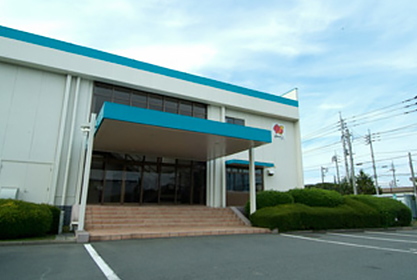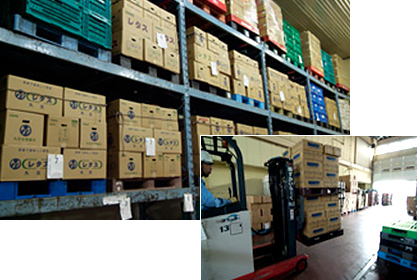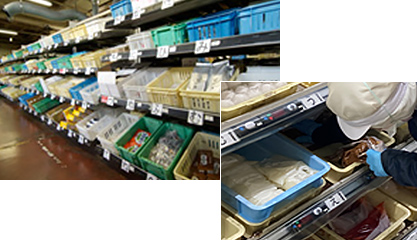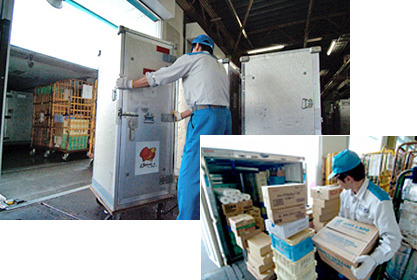Transporting everything from processed ingredients to tableware and lab coats:
an efficient distribution line that connects our central kitchens and stores.
Transportation System for Maintaining Freshness
In order to deliver food in a fresh state, Skylark delivers products primarily from its central kitchens (10 locations) to its in all 47 prefectures in Japan. In order to maintain the ideal temperature range depending on the ingredients, we decide the necessary amount of carbon dioxide gas to use based on the temperature each day and the distance to the store, and inject it into our cooling boxes accordingly before delivery.
Daily Delivery from 10 Locations Nationwide
Skylark Group operates 10 central kitchens located throughout Japan that manage and prepare ingredients. Fresh and delicious ingredients are delivered every day from the central kitchens in each region to Skylark Group stores in all prefectures.
Approximately 400 trucks are in operation every day. Although the number is small when considering delivery to each of Skylark Group's approximately 2,600 stores each day, we are working to improve efficiency by devising strategic ways such as visiting multiple stores with one vehicle.

Skylark has 10 central kitchen locations nationwide.

Ingredients are delivered daily to stores in 47 prefectures.
Eliminating Excess Inventory and Consolidating Logistics to Keep Costs Down

Skylark has very little excess inventory.Transporting everything and unifying logistics.
One central kitchen provides deliveries for up to around 500 stores. With daily production and daily deliveries, there is not much need for excess inventory. For vegetables, we also limit the use of preservatives as much as possible and send the ordered amounts to manufacturing in a fresh state. This reduces waste and leads to cost reductions.
With the exception of some ingredients such as cola and ice cream, all ingredients and supplies are delivered from our central kitchens. This includes everything from oil and hand towels to ballpoint pens, notepads and toilet paper. We will deliver even a single item of tableware. Laundry is also collected from stores and sent for cleaning in bulk from the central kitchens. If left to each individual store, laundry operators and logistics will differ, and be more costly. Central kitchens also serve as a "backyard" for our stores, unifying logistics and eliminating the need for excess inventory on the store side.
Preventing Shipping Errors with Instructions using Symbols

All ingredients are subdivided by symbols.Ingredients are sorted by store destination.
There is also an inventive trick to the instructions used for summarizing various order requests from stores. With hundreds of product names to be ordered and menus that change each season, it can be difficult to remember product names, and ordering mistakes are likely to occur. For this reason, order instructions do not use product names, but rather katakana letters, numbers, and alphabetical letters to enable subdivision of markings. Even if new product names increase or decrease, they can be memorized immediately, which greatly reduces shipping errors and leads to greater efficiency.
One Truck Can Deliver to Multiple Stores for Improved Efficiency

Ingredients are placed in a refrigerated box and carriedby truck, together with daily necessities used at the stores.
The first trucks depart from our central kitchens every day at 7:30 am. Around 80 trucks operate in a day, and loading times are around 3–5 minutes. The necessary amount of cold storage boxes containing ingredients to be delivered to stores are loaded, and trucks depart in virtually no time at all.
Primary processed ingredients are cooled in refrigerated boxes and transported at low temperatures to maintain freshness. Tableware, stationery and other items ordered by stores are also loaded and carried together. Trucks also deliver to a fixed area. Since one truck can visit multiple stores, this also helps to reduce costs such as labor and fuel costs.